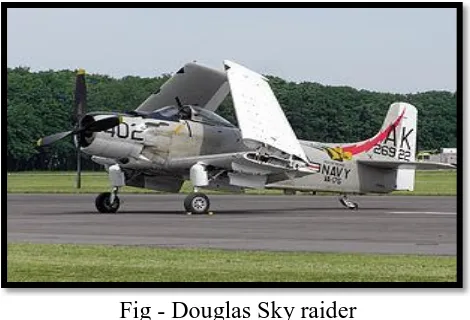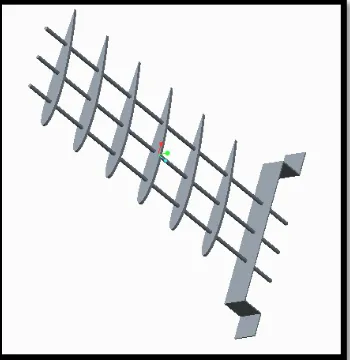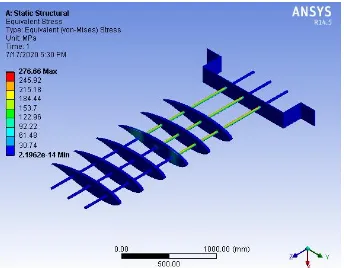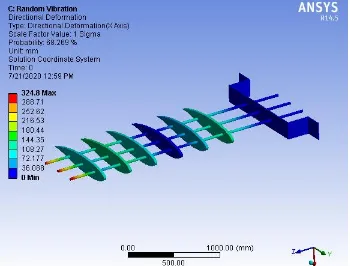Fracture Analysis Of Fuselage And Wing
Joint
MEDISETTY PUSHPA LATHA received the B.Tech degree in mechanical engineering from GAYATRI VIDYA PARISHAD COLLEGE OF ENGINEERING, VISAKHAPATNAM, ANDHRA PRADESH, INDIA, in 2015 year, and perusing M.Tech in CAD/CAM from GONNA INSTITUTIONS OF INFORMATION TECHNOLOGY AND
SCIENCES, GONNAVANIPALEM, VISAKHAPATNAM, ANDHRA PRADESH, INDIA.
Mr. K. HARI SINGH, M.Tech, Associate Professor, GONNA INSTITUTIONS OF INFORMATION TECHNOLOGY AND SCIENCES, GONNAVANIPALEM, VISAKHAPATNAM, ANDHRA PRADESH, INDIA.
ABSTRACT
The main aim of this thesis is to investigate the fatigue crack and growth by fracture analysis in an aircraft fuselage and wing joint by determining the stress intensity factors, deformation and compared with alloy and composite materials. The materials considered are Al 6061, E- glass fiber, aramid fiber, technetium. 3D modeling will be done in Creo and fracture analysis will be done in Ansys 14.5.
INTRODUCTION
The body is Associate in nursing aircraft's main body section. It holds crew, passengers, and cargo. In single-engine craft it'll typically contain Associate in nursing engine, as well, though in some airplane the one engine is mounted on a pylon connected to the body that successively is employed as a floating hull. The body conjointly serves to position management and stabilization surfaces in specific relationships to lifting surfaces that is needed for craft stability and maneuver ability.
Fig - Douglas Sky raider
Rib
By analogy with the anatomical definition of "rib", the ribs attach to the most spar, and by being perennial at frequent intervals, type a skeletal form for the wing. Sometimes ribs incorporate the device form of the wing, and therefore the skin adopts this form once stretched over the ribs
Fig - Wing ribs of a de Havilland DH.60 Moth
LITERATURE REVIEW
Dinesh kumar K, Sai Gopala Krishna V.V, Syed Shariq Ahmed, Meer Abdul Irfan [1],
Have designed a Wing-Bracket interaction that wasn't nonetheless designed by any of the trade. And calculable the fatigue lifetime of our Wing-Bracket attachment model. Here compared the fatigue lifetime of our model with 3 materials like Maraging Steel, Ti and Structural A36 steel. Among this 3 we've got verified that Maraging steel offers a lot of fatigue life compared to alternative 2 materials. For estimating the fatigue life created some hand calculations. Finally depicted the fatigue life with the assistance of Benjamin David Goodman Curve. The Structural element is intended and analyzed exploitation CATIA and ANSYS Software’s. In analysis the most stress at that the element undergoes degradation/damage is calculated for various finish Conditions (loadings and stresses), which determines the fatigue lifetime of the element.
Md. Abdul Wajeed, Babu Reddy [2], included the linear static analysis of the partition frames alongside spar beam and fatigue harm estimation at the crucial location because of unsteady masses. Lugholes and bolt-holes area unit possible to expertise a lot of stress because of high stress concentration. Stress analysis is administrated finite component methodology. An area analysis is administrated to capture high stress magnitude and stress distribution. Frame experiences variable loading throughout flight conditions. A typical transport craft load spectrum is used for fatigue harm calculation. During a aluminiferous structure fatigue manifests itself within the type of a crack, that propagates. If the crack during a critic allocation goes overlooked it could lead on to a ruinous failure of the frame. Fatigue harm estimation are administrated exploitation constant amplitude S-N knowledge for varied stress ratios and native stress history at stress concentration.
methodology is employed for the strain analysis. Within the current project, trials are going to be created to predict the fatigue lifetime of wing-fuselage attachment bracket in a very transport framing. In a very antimonial structure fatigue manifests itself within the style of a crack that propagates. Fatigue cracks can seem at the placement of high tensile stress locations. These locations are invariably of high stress concentration. Fatigue life calculation are going to be meted out for typical service loading condition exploitation constant amplitude S-N information for numerous stress ratios and native stress history at stress concentration. During this modeling CATIA V5 software system is employed and for analysis tool MSC/ PATRAN and MSC/ NASTRAN 2010.
Fig: Final Assembly of Wing and Fuselage Joint
ANALYSIS OF WING JOINT
MATERIAL – ALUMINUM ALLOY 6061 FRACTURE ANALYSIS
Fig – Crack
Fig – J – Integral on wing joint using Aluminum alloy 6061
Fig - Equivalent Von-Mises Strain of wing joint using Aluminum Alloy 6061
Fig - Total deformation of wing joint using Aluminum Alloy 6061
RANDOM VIBRATION ANALYSIS
Fig – Shear Stress forAluminum Alloy 6061
Fig – Shear Elastic Strain for Aluminum Alloy 6061
Fig – Directional Deformation for Aluminum Alloy 6061
RESULTS
Material Deformation (mm)
Stress
(MPa) Strain
Stress Intensity factor
E glass fiber 328.66 276.02 0.0039688 41.219 8.0963
-1.4907 0.03404
Aramid fibers 21.539 276.69 0.025369 43.351 9.406
-2.4193 0.23452
Technetium 73.69 276.6 0.00086647 42.748 9.0443
-2.1665 0.0079679
MODAL ANALYSIS GRAPHS
Comparison of deformation values of no modes for different materials
Comparison of frequency values of no modes for different materials
RANDOM VIBRATION ANALYSIS
MATERIALS Directional Deformation (mm)
Shear Stress
(MPa) Shear Strain
Aluminum Alloy 6061 324.8 232.37 0.0089712
E glass fiber 335.16 150.04 0.0049737
Aramid fibers 286.13 34.974 0.0085845
Technetium 731.78 2282.5 0.018572
CONCLUSION
A semi elliptical crack with radius of mm is given at the joint of wing and cylinder. Fracture analysis, static structural analysis, modal analysis and Random vibration analysis is done using materials Aluminum alloy, E glass fiber, Aramid fiber (Kevlar 49M) and technetium.
By observing fracture analysis results, the stress intensity factor is less when E glass fiber is used and more when aramid fiber is used. But the variation between all those is very minute between all the materials.
By observing static structural analysis results, stress is more when aramid fiber is used. The stress is increasing for aramid fiber by about 2% when compared with Aluminum alloy, by about
0 50 Def o rm a tio n (m m )
COMPARISON OF DEFORMATION VALUES OF NO OF MODES FOR
DIFFERENT MATERIALS 1 2 0 200 Fre q u ency ( H z)
COMPARISON OF FREQUENCY VALUES OF NO OF MODES FOR
DIFFERENT MATERIALS
1
2
3% when compared E glass Fiber and by about 1.5% when compared with technetium. The stress value is less when technetium is used but the deformation is also less when it is used. By observing modal analysis results, the frequency is less when Aramid is used and more when technetium is used. The frequency is increasing for technetium by about 35% when compared with Aluminum alloy, by about 45% when compared E glass fiber and by about 70% when compared with Aramid fiber. Due to the increase of frequencies, the vibrations will be more when technetium is used.
By observing random vibration analysis results, the shear stress is less when Aramid is used due to lesser frequency values and more when technetium is used due to higher frequency values. The shear stress is increasing for technetium by about 67% when compared with Aluminum alloy, by about 81% when compared Carbon Fiber and by about 97% when compared with Aramid. So it can be concluded that using Aramid fiber (Kevlar 49M) sustains more life than other materials due to initiation of a crack at the wing and fuselage joint.
REFERENCES
1. Dinesh kumar K, Sai Gopala Krishna V.V, Syed Shariq Ahmed, Meer Abdul Irfan, ,
Fatigue Analysis of Fuselage & Wing Joint, international journal of research in aeronautical and mechanical engineering, volume1 2013.
2. Md. Abdul Wajeed, Babu Reddy, Stress Analysis of Fuselage Frame with Wing Attachment Beam and Fatigue Damage Estimation, International Journal of Engineering Research & Technology Vol. 4 Issue 11, November-2015
3. Sriranga B.k1, Kumar .R2, stress analysis and fatigue life prediction of wing- fuselage lug joint attachment bracket of a transport aircraft, IJRET: International Journal of Research in Engineering and Technology,Volume: 03 Special Issue: 03 | May-2014 |. 4. N. Bhaskara Rao, K. Sambasiva Rao, Dynamic Analysis and Fatigue Life Estimation
of Wing Fuselage Attachment Bracket of an Airframe Structure, IJSRD - International Journal for Scientific Research & Development| Vol. 4, Issue 12, 2017 |
5. Rudrapala Kirankumar, Mr. M. Ganesh, B.Dinesh Kumar, Design and Fatigue
Analysis of Fuselage and Wing Joint, International journal & magazine of engineering technology, management and reaserch, volume 2,issue 9.
6. Vijayanandh Raja, Raj Kumar G, Structural analysis of Aircraft fuselage splice joint, Materials Science and Engineering, 2016.
7. K E Girish, Chetan, fatigue life estimation of rear fuselage structure of an aircraft, IJRET: International Journal of Research in Engineering and Technology, Volume: 04 Issue: 07 | July-2015.
8. Shashikumar.C, Nagesh.N, Ganesh, Design and Analysis of Wing fuselage attachment
bracket for fighter aircraft, International Journal of Engineering Research and General Science Volume 4, Issue 1, January-February, 2016.




